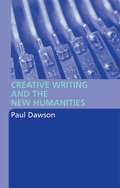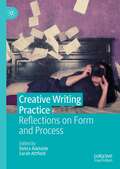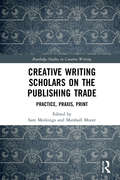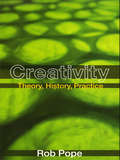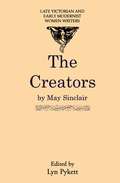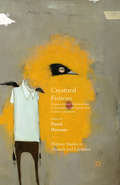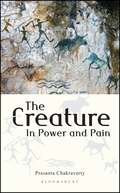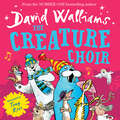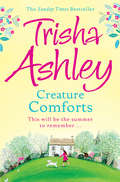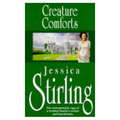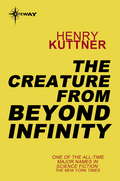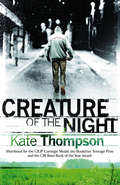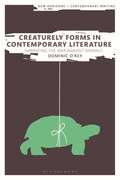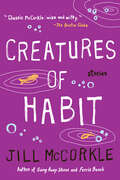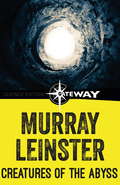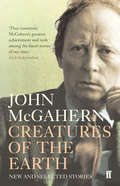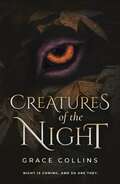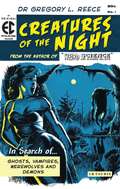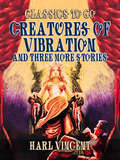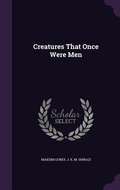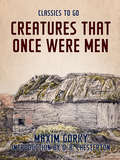- Table View
- List View
Creative Writing and the New Humanities
by Paul DawsonThis book examines the institutional history and disciplinary future of creative writing in the contemporary academy, looking well beyond the perennial questions 'can writing be taught?' and 'should writing be taught?'.Paul Dawson traces the emergence of creative writing alongside the new criticism in American universities; examines the writing workshop in relation to theories of creativity and literary criticism; and analyzes the evolution of creative writing pedagogy alongside and in response to the rise of 'theory' in America, England and Australia.Dawson argues that the discipline of creative writing developed as a series of pedagogic responses to the long-standing 'crisis' in literary studies. His polemical account provides a fresh perspective on the importance of creative writing to the emergence of the 'new humanities' and makes a major contribution to current debates about the role of the writer as public intellectual.
Creative Writing and the New Humanities
by Paul DawsonThis book examines the institutional history and disciplinary future of creative writing in the contemporary academy, looking well beyond the perennial questions 'can writing be taught?' and 'should writing be taught?'.Paul Dawson traces the emergence of creative writing alongside the new criticism in American universities; examines the writing workshop in relation to theories of creativity and literary criticism; and analyzes the evolution of creative writing pedagogy alongside and in response to the rise of 'theory' in America, England and Australia.Dawson argues that the discipline of creative writing developed as a series of pedagogic responses to the long-standing 'crisis' in literary studies. His polemical account provides a fresh perspective on the importance of creative writing to the emergence of the 'new humanities' and makes a major contribution to current debates about the role of the writer as public intellectual.
Creative Writing Practice: Reflections on Form and Process
by Debra Adelaide Sarah AttfieldCreative Writing Practice: reflections on form and process explores the craft of creative writing by illuminating the practices of writers and writer-educators. Demonstrating solutions to problems in different forms and genres, the contributors draw on their professional and personal experiences to examine specific and practical challenges that writers must confront and solve in order to write. This book discusses a range of approaches to writing, such as the early working out of projects, the idea of experimentation, of narrative time, and of failure. With its strong focus on process, Creative Writing Practice is a valuable guide for students, scholars and practitioners of creative writing.
Creative Writing Scholars on the Publishing Trade: Practice, Praxis, Print (Routledge Studies in Creative Writing)
by Sam MeekingsIn Creative Writing Scholars on the Publishing Trade: Practice, Praxis, Print, Sam Meekings and Marshall Moore, along with prominent scholar-practitioners, undertake a critical examination of the intersection of creative writing scholarship and the publishing industry. Recent years have seen dramatic shifts within the publishing industry as well as rapid evolution and development in academic creative writing programs. This book addresses all of these core areas and transformations, such as the pros and cons of self-publishing versus traditional publishing, issues of diversity and representation within the publishing industry, digital transformations, and possible career pathways for writing students. It is crucial for creative writing pedagogy to deal with the issues raised by the sudden changes within the industry and this book will be of interest to creative writing students and practitioners as well as publishing students and professionals.
Creative Writing Scholars on the Publishing Trade: Practice, Praxis, Print (Routledge Studies in Creative Writing)
by Sam Meekings Marshall MooreIn Creative Writing Scholars on the Publishing Trade: Practice, Praxis, Print, Sam Meekings and Marshall Moore, along with prominent scholar-practitioners, undertake a critical examination of the intersection of creative writing scholarship and the publishing industry. Recent years have seen dramatic shifts within the publishing industry as well as rapid evolution and development in academic creative writing programs. This book addresses all of these core areas and transformations, such as the pros and cons of self-publishing versus traditional publishing, issues of diversity and representation within the publishing industry, digital transformations, and possible career pathways for writing students. It is crucial for creative writing pedagogy to deal with the issues raised by the sudden changes within the industry and this book will be of interest to creative writing students and practitioners as well as publishing students and professionals.
Creativity: Theory, History, Practice
by Rob PopeCreativity: Theory, History, Practice offers important new perspectives on creativity in the light of contemporary critical theory and cultural history. Innovative in approach as well as argument, the book crosses disciplinary boundaries and builds new bridges between the critical and the creative. It is organised in four parts: Why creativity now? offers much-needed alternatives to both the Romantic stereotype of the creator as individual genius and the tendency of the modern creative industries to treat everything as a commodity defining creativity, creating definitions traces the changing meaning of 'create' from religious ideas of divine creation from nothing to advertising notions of concept creation. It also examines the complex history and extraordinary versatility of terms such as imagination, invention, inspiration and originality dreation as myth, story, metaphor begins with modern re-tellings of early African, American and Australian creation myths and – picking up Biblical and evolutionary accounts along the way – works round to scientific visions of the Big Bang, bubble universes and cosmic soup creative practices, cultural processes is a critical anthology of materials, chosen to promote fresh thinking about everything from changing constructions of 'literature' and 'design' to artificial intelligence and genetic engineering. Rob Pope takes significant steps forward in the process of rethinking a vexed yet vital concept, all the while encouraging and equipping readers to continue the process in their own creative or 're-creative' ways. Creativity: Theory, History, Practice is invaluable for anyone with a live interest in exploring what creativity has been, is currently, and yet may be.
Creativity: Theory, History, Practice
by Rob PopeCreativity: Theory, History, Practice offers important new perspectives on creativity in the light of contemporary critical theory and cultural history. Innovative in approach as well as argument, the book crosses disciplinary boundaries and builds new bridges between the critical and the creative. It is organised in four parts: Why creativity now? offers much-needed alternatives to both the Romantic stereotype of the creator as individual genius and the tendency of the modern creative industries to treat everything as a commodity defining creativity, creating definitions traces the changing meaning of 'create' from religious ideas of divine creation from nothing to advertising notions of concept creation. It also examines the complex history and extraordinary versatility of terms such as imagination, invention, inspiration and originality dreation as myth, story, metaphor begins with modern re-tellings of early African, American and Australian creation myths and – picking up Biblical and evolutionary accounts along the way – works round to scientific visions of the Big Bang, bubble universes and cosmic soup creative practices, cultural processes is a critical anthology of materials, chosen to promote fresh thinking about everything from changing constructions of 'literature' and 'design' to artificial intelligence and genetic engineering. Rob Pope takes significant steps forward in the process of rethinking a vexed yet vital concept, all the while encouraging and equipping readers to continue the process in their own creative or 're-creative' ways. Creativity: Theory, History, Practice is invaluable for anyone with a live interest in exploring what creativity has been, is currently, and yet may be.
The Creators (Late Victorian and Early Modernist Women Writers)
by May Sinclair Lyn PykettMay Sinclair's The Creators is a study of a group of writers and would-be writers and their struggles and/or accommodations withing the literary marketplace. It deals with the trials and tribulations of literary celebrity and with lack of recognition. It also focuses on the doubts and self-divisions of the artist and on his or her battles with conventional gender roles. The novel's subtitle - 'a comedy' - puzzled some of its first readers and reviewers, the TLS to speculate that the comedy must lie in that fact that the creators believe that they are geniuses. Sinclair does not take her characters as seriously as they take themselves, but her social comedy also exposes the limitations of the conventional middle-class world which either exploits or fails to understand them. First serialized in the Century Illustrated Monthly Magazine between November 1909 and October 1910, The Creators was first published in book form by John Constable in 1910. This edition restored the numerous and extensive cuts that were made to Sinclair's manuscript during the process of the novel's serialization.
Creatural Fictions: Human-Animal Relationships in Twentieth- and Twenty-First-Century Literature (Palgrave Studies in Animals and Literature)
by David HermanThis volume explores how twentieth- and twenty-first-century literary texts engage with relationships between humans and other animals. Written by forward-thinking early-career scholars, as well as established experts in the field, the chapters discuss key texts in the emergent canon of animal narratives, including Franz Kafka's animal stories, Yann Martel's The Life of Pi, Zakes Mda's The Whale Caller, and others. The volume is divided into four main sections. Two period-focused sections center on modernism and on late-twentieth- and twenty-first-century fiction, while two further sections foreground the more general project of theory building in literary animal studies, examining interconnections among concepts of species, sexuality, gender, and genre. The volume also raises issues that extend beyond the academic community, including ethical dimensions of human-animal relationships and the problems of species loss and diminishing biodiversity.
The Creature: In Power and Pain
by Prasanta ChakravartyThe Creature is an invitation to follow the mechanics between power and pain, which begets the creature. Creatures confront power in, and through, conjunctures of radical contingency. The casual use of power is an exercise in distraction. It is an abiding conundrum that those who endure affliction also exert it as a force over other living bodies in equal measure-not as acts of vengeance or bad faith, but through deeds of forgetful randomness. To ensure social indemnity and security, creatures exercise force over kindred embodiments through a process of collective mimicry. In the bargain, creatures begin to disfigure and distort each other. The line between mutual slaughter and mutual embrace begins to blur. Each transgresses its own soul. At other times, power is an opaque, magisterial and disdainful style of conveyance. It reveals itself out of nowhere. But the steadfast creature is as resilient as it is vulnerable. The more it endures, the greater its perdurance. Perduring creatures may sometimes gain a second sight, forged out of a sense of lyricality, love and abdication. But is abdication, or taking refuge in the wondrous, sufficient to release all creatures from the fatal loop of power and pain? Or will they have to slowly shed creaturely affliction by a rigorous process of decreation?Sifting through the writings of Giambattista Vico, Niccolò Machiavelli, Gabriel Tarde, Miguel de Unamuno, Jibanananda Das, Lev Shestov, Raymond Geuss, Jean Starobinski, Ernst Bloch, Simone Weil, Simon Critchley, Sarah Kane and others, this volume explores the creaturely predicament and its possibilities of freedom.The five chapters in Book I lay down fundamental questions for the creaturely condition: the question of mimicry, the relationship between taking initiative and being hounded, the bridge between senses and destitution, and the vehemence of radical contingency. Book II posits the question of skepticism, fideism and their connection to resilience and generosity in creatures. Book III is entirely devoted to various ways of conceiving the aesthetic: through the tragic, the epiphanic, the catastrophic and through militant material eruptions. Book II and III essentially delve into the sites of freedom that lurk within the condition of the creaturely. Book IV is constituted of a single chapter on the subject of decreation; it grapples with questions of attention, anonymity and abdication.
The Creature Choir
by David WalliamsSing your heart out this Christmas with a whole choir of characters, in the showstopping new picture book from number one bestselling author David Walliams, illustrated by the artistic genius, Tony Ross!
Creature Comforts
by Trisha AshleyFrom the No.1 bestselling author of The Christmas Invitation This will be the summer to remember…
Creature Comforts: Book Two (Patterson Family Saga)
by Jessica StirlingThe second novel in Stirling's historical saga brings to light yet more dark secrets, amorous entanglements and murder...Elspeth and Anna Patterson of Balnesmoor have both married well: Elspeth to a wealthy wool merchant, Anna to the son of a respected factor. But they are far from happy. The two married sisters, leading oddly parallel lives, find themselves entangled in a web of infidelity, scandal, and heartache in the midst of Wellington's Peninsular War on the continent.The story continues in Hearts of Gold.
The Creature From Beyond Infinity
by Henry KuttnerLike a great, lethal snake, plague creeps through the galaxies. No conscious entity can halt its progress, and life is slowly draining from planet after planet.Only one super-intelligence is capable of preventing cataclysm. To do it, he must penetrate far beyond infinity - to the formless, deathless creature out to kill the universe.
Creature of the Night
by Kate ThompsonI could hear Dennis talking to my ma. 'She was little,' he said. 'Little like me. But old. Older than you.' Those words gave me a cold shock. I could see Dennis imagining fairies, but old ones?When Bobby's mother moves the family into a rented house in the country, a neighbour tells him that a child was once murdered there. Bobby doesn't care. All he wants is to get back to Dublin and to resume his wild life there, stealing from the crowded shopping streets and racing stolen cars at night. But getting his old life back doesn't turn out to be so easy, and the longer he spends in the old cottage, the more convinced he becomes that something very strange is going on there. Was there really a murder? And if so, was it the one he has been told about?
Creaturely Forms in Contemporary Literature: Narrating the War Against Animals (New Horizons in Contemporary Writing)
by Dominic O'KeyWe are living through a period of planetary crisis, a time in which the mass production and consumption of some animals is made possible by the mass extinction of many others. What is the role of literature in responding to this war against animals? How might literary criticism read for animals?In Creaturely Forms in Contemporary Literature, Dominic O'Key develops the bold argument that deep attention to literary form enables us to rethink human-animal relations. Through chapters on W. G. Sebald, J. M. Coetzee and Mahasweta Devi, as well as close readings of works by Arundhati Roy and Richard Powers, O'Key reveals how literary forms can unsettle the fictions of human supremacy and craft alternative, creaturely forms of relation.An intervention into both the humanism of literary theory and the representational focus of animal studies, this provocative work makes the case for a new formalism in light of our obligation to fellow creatures.
Creaturely Forms in Contemporary Literature: Narrating the War Against Animals (New Horizons in Contemporary Writing)
by Dominic O'KeyWe are living through a period of planetary crisis, a time in which the mass production and consumption of some animals is made possible by the mass extinction of many others. What is the role of literature in responding to this war against animals? How might literary criticism read for animals?In Creaturely Forms in Contemporary Literature, Dominic O'Key develops the bold argument that deep attention to literary form enables us to rethink human-animal relations. Through chapters on W. G. Sebald, J. M. Coetzee and Mahasweta Devi, as well as close readings of works by Arundhati Roy and Richard Powers, O'Key reveals how literary forms can unsettle the fictions of human supremacy and craft alternative, creaturely forms of relation.An intervention into both the humanism of literary theory and the representational focus of animal studies, this provocative work makes the case for a new formalism in light of our obligation to fellow creatures.
Creatures of Habit
by Jill McCorkleJill McCorkle's new collection of twelve short stories is peopled with characters brilliantly like us-flawed, clueless, endearing. These stories are also animaled with all manner of mammal, bird, fish, reptile-also flawed and endearing. She asks, what don't humans share with the so-called lesser species? Looking for the answer, she takes us back to her fictional home town of Fulton, North Carolina, to meet a broad range of characters facing up to the double-edged sword life offers hominids. The insight with which McCorkle tells their stories crackles with wit, but also with a deeper-and more forgiving-wisdom than ever before. In Billy Goats, Fulton's herd of seventh graders cruises the summer nights, peeking into parked cars, maddening the town madman. In Monkeys, a widow holds her husband's beloved spider monkey close along with his deepest secrets. In Dogs, a single mother who works for a veterinarian compares him-unfavorably-with his patients. In Snakes, a seasoned wife sees what might have been a snake in the grass and decides to step over it. And, in the exquisite final story, Fish, a grieving daughter remembers her father's empathy for the ugliest of all fishes. The success behind Jill McCorkle's short stories-and her novels-is, as one reviewer noted, her skill as an archaeologist of the absurd, an expert at excavating and examining the comedy of daily life (Richmond Times-Dispatch). Yes, and also the tragedy.
Creatures of the Abyss: Or, The Listeners
by Murray LeinsterOrejas de ellos, the things who listen, whispered the superstitious fishermen when the strange occurrences began off the Philippine coast. How else could you explain the sudden disappearance of a vessel beneath a mysterious curtain of foam? The writhings of thousands of maddened fish trapped in a coffin-like area of ocean? An alien intelligence gorged at the bottom of the Luzon Deep and made its plans. Radar expert Terry Holt and the crew of the Experance had to devise a weapon against the horrifying creatures which threatened mankind with extinction.
Creatures of the Earth: New and Selected Stories
by John McGahernJohn McGahern is considered by many to be the most important Irish prose writer of the last fifty years. McGahern's short stories equal his finest novels, reflecting both the richness of the ordinary, and the extraordinary, in the lives of a variety of individuals: the jilted lover waiting with would-be writers in a Dublin pub on a summer evening; the bitter climax between a father and son as a marriage begins; the fortunes and misfortunes of the Kirkwood family; and many more.For this revised edition, completed shortly before his death, John McGahern edited and deleted a number of stories from the Collected Stories that first appeared in 1992. This is the authorised edition of a modern classic.'He writes with authority and gravity, and with an instinct for the most appropriate detail . . . His terse narrative seems free and full. He has the gift of being able to move fluently and unselfconsciously between a simple and a heightened style.' Times Literary Supplement'One of the greatest writers of our era.' Hilary Mantel, New Statesman
Creatures of the Night (A Wattpad Novel)
by Grace CollinsMilena, an obedient teenager, has to team up with the supernatural creatures she was taught to fear in order to escape the people she once loved...In a world where humans must hide underground to stay safe from the creatures who roam the night, Milena's life as an outcast is hardly worth noticing. But on the day her village is attacked and her life is spared by the mysterious Elias, Milena is forced to throw everything she thought she knew about her world out the window.Because while Elias looks just as human as she is, he's actually the leader of a pack of wolf shifters, and the bond she feels with him compels her to start asking questions about the things she's been told about the creatures of the night. Because if her village was willing to lie about something like this, what other secrets might they be keeping from her?
Creatures of the Night: In Search of Ghosts, Vampires, Werewolves and Demons
by Gregory L. ReeceVampires and werewolves; phantoms and phantasms: looming out of the fog leaps the menacing spectre of the lycanthrope, ghoul or blood-crazed zombie. Intrigued by some of the most sinister, yet at the same time most compelling, legends of western civilization, Gregory L. Reece dusts down his stake and crucifix, loads his silver bullets and takes off into the wilds in search of answers and fresh adventures. Rummaging around in crumbling tombs and cobwebbed sarcophagi, his latest quest leads him into the haunted realm of the dead and the undead: of those carnivorous, nocturnal hunters that might perhaps better be left undisturbed. Why, he asks, is our culture obsessed by the eerie and the macabre? Why, despite its horrors, does the 'dark side' of the supernatural - its séances and ghost-hunting, demonic possession and the occult - call to us with such dangerous allure? Whether tracking night-stalking werewolves, chanting black magic mantras with Satanists, or interviewing a funereal modern-day Count Dracula, Reece is determined to uncover the truth. A wry exploration of a secret and secretive subculture, Creatures of the Night is at the same time a bold and startling journey into a wraithlike world that has so often seemed to lie beyond the limits of rational comprehension - until now.
Creatures Of Vibration and Three More Stories (Classics To Go)
by Harl VincentFour Classic Science Fiction Stories from the "Golden Age" by Harl Vincent. Featured stories: Creatures Of Vibration, Wanderer Of Infinity, The Copper-Clad World and Vulcan's Workshop.
Creatures That Once Were Men
by Maksim GorkyA collection of short stories by the popular and influential Russian author, a founder of the socialist realism literary method and arguably the greatest Russian literary figure of the 20th century. He wrote stories, plays, memoirs and novels which touched the imagination of the Russian people, and was the first Russian author to write sympathetically of such characters as tramps and thieves, emphasizing their daily struggles against overwhelming odds.
Creatures That Once Were Men (Classics To Go)
by Maxim Gorky(Excerpt): "In front of you is the main street, with two rows of miserable looking huts with shuttered windows and old walls pressing on each other and leaning forward. The roofs of these time-worn habitations are full of holes, and have been patched here
